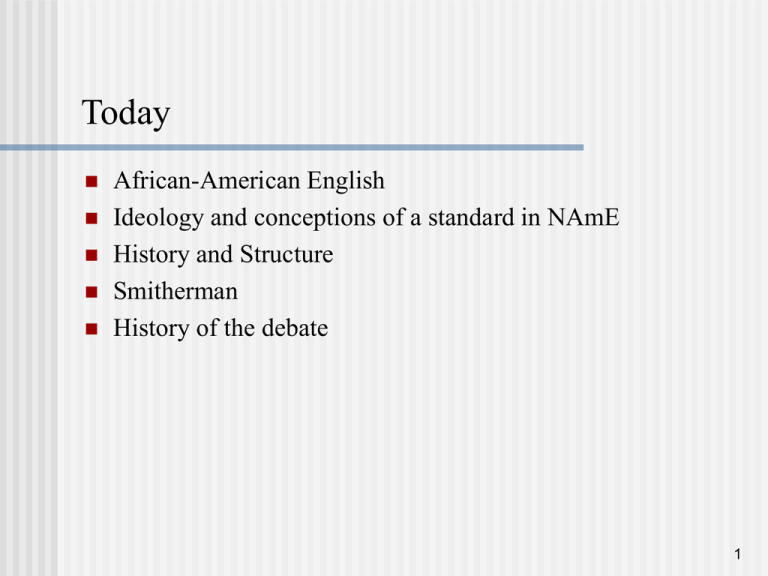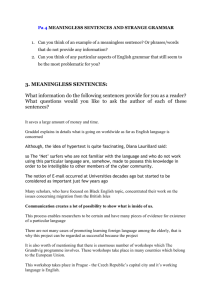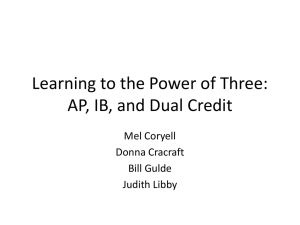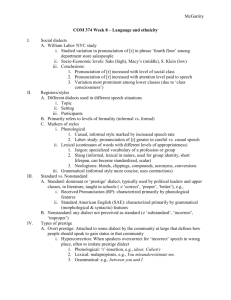Document
advertisement

Today African-American English Ideology and conceptions of a standard in NAmE History and Structure Smitherman History of the debate 1 Issues in the Ebonics Debate Topics bearing on discussion of AAE: (1.) relation to comparable Anglo-American varieties (2.) historical roots and development Questions appearing in the media: Is it a language (like Chinese or French?) Is it a valid dialect (like British English or Singaporean English?) Or, is it street slang? Responses and comments made in answer to these questions: Is it a problem that blacks don’t talk like other Americans? Is my child going to be negatively affected by being around black speakers? Do you believe in Ebonics? 2 History and Development of AAE Rickford, J. & Rickford, R. (2000) Spoken Soul. Johnathan Wiley The debate: Creole origins or English origins? 17th century: slaves were brought from Western Africa (Guinea Coast/Nigeria, Ghana, Sierra Leone) and previously-established British colonies, particularly in Barbados and Jamaica. •Native African languages included: Wolof, Mandingo, Hausa. •Likely West African Pidgin English (WAPE) developed in the “Middle passage”, precursor to a creole spoken by slaves transported to Virginia and South Carolina colonies (evidence, e.g., Gullah Creole) •AAE did not remain a creole for long, because (unlike in the Caribbean where creoles remained the first languages of most of the population), African slaves in the US South had significantly greater contact with English speakers. 1690: Jamaica = 75% African Virginia = 5% 3 History and Development of AAE 18th century: Three groups of speakers among the slaves: (1) Those learning English of their masters, (2) Native-born field workers who spoke the creole, (3) Recent imports from Africa, some of whom spoke a Caribbean creole. 19th century: Legal slaving ends; illegal trade continues, particularly in the South Coastal U.S. Slaves are transported across state lines. Inventions, such as the cotton gin, increased the interest in bringing in more slaves to work cotton fields. 1790: 700,000 slaves 1860: 4 million 20th century: “Great Migration” from the South to the West (CA, WA), explaining similarities between AAE in the South and West. Migrated to areas with segregated housing and schools. 4 Ideology and AAE: what’s in a name? •Non-standard Negro English (NNE) - 1950’s •Black Vernacular English (BVE) - 1960’s •Black English Vernacular (BEV) - 1970’s, 80’s •African-American Vernacular English - (AAVE) late 1980’s, early 90’s •African-American English 5 AAE: what’s in a name? •Non-standard Negro English (NNE) - 1950’s •Black Vernacular English (BVE) - 1960’s •Ebonics - 1960’s •Black English Vernacular (BEV) - 1970’s, 80’s •African-American Vernacular English - (AAVE) late 1980’s, early 90’s •Ebonics -1996-7 •African-American English (AAE) - present •Spoken Soul - literary - Claude Brown, author 6 AAE: Rulings and Resolutions Rulings: Martin Luther King Jr. Elementary School Children, et al., vs. Ann Arbor School District Board (1979, District Court, Judge C. Joiner) Resolution: Linguistic Society of America (1997) http://www.lsadc.org/info/ling-faqs-ebonics.cfm 7 Issues in the Debate 1996: Oakland (CA) Unified School District Board resolution Some key passages: 1. “…recognize the existence and the cultural and historic bases of West and Niger-Congo African Language Systems, and these are the language patterns that many African American students bring to school.” Popular interpretation: Ebonics is an African language. Linguistic understanding: Language varieties typically incorporate items from other language sources in the formation of a new dialect or sociolect. Ebonics has traces of a creole language, and Anglo varieties of English. •Issue: chasm developed between popular language beliefs and professional, technical knowledge in the description and analysis of human language. •Issue: ideology shapes our thinking about language issues. 8 Issues in the Debate 1996: Oakland (CA) Unified School District Board resolution Some key passages: 2. “Implement the best possible academic program for the combined purposes of facilitating the acquisition of and mastery of English language skills, while respecting and embracing the legitimacy and richness of the language patterns whether they are known as “Ebonics,” “African Language Systems,…” Popular interpretation: students will be taught in Ebonics, and teachers will be taught to use Ebonics in instruction. Linguistic understanding: In teaching General American English, students’ community dialect should be respected. Understanding how they work will help teachers “take students from where they are to where they need to go.” 9 Standard Language Ideology Standard Language Ideology: Socially-constructed notion of the nature, boundaries, etc. of a language; particularly of a “standard” variety of a language, supported by social sanction. Sanctions provide a rationale for codification, elaboration, and prescriptive norms. (Woolard, 1991; Silverstein 1992, 1995; Gal and Irvine, 1995; Lippi-Green, 1997; Irvine and Gal 2000; Milroy, 2000) Much sociolinguistic research assumes a direct correlation between a linguistic feature and a social characteristic. Silverstein (1992, 1995) refers to this direct correlation as first-order indexicality Indexicality -- ability of a form to stand in an emblematic relation First-order indexicality --- The association of a linguistic form or variety with a social group, e.g., “such and suches use form X while so and so’s use form Y”. -- Ideology constitutes a system for making sense of the indexicality in language 10 Language Ideology Second-order indexicality – -- any reasoning that interprets such a presuppositional relationship – “is potentially an ideological one rationalizing the indexical value of the forms in terms of schemata of social differentiation and classification that are independent of the usages at issue.” (Silverstein, 1992:316) -- "the noticing (overt or covert), discussion and rationalization" of basic first-order indexicality (Milroy, 2000) “correlation is in fact mediated by an ideological interpretation of the meaning of language use” (Woolard, 1992:242) second-order indexicality refers to the reactions of speakers to first-order indexicality and these reactions, viewed as manifestations of ideological stances, are evident both in language behavior (hypercorrection, style shifting) and in overt comment about language and, we suggest, about other social phenomena as well. 11 Language Ideology Application First-order indexicality – The association of a linguistic form or variety with a social group, e.g., “such and suches use form X while so and so’s use form Y”. Class I Argentinian speakers show 68% prepausal /s/-deletion in casual speech, while Class VI speakers show 14%. Second-order indexicality-Class I Argentinian speakers show higher frequency of nonstandard productions…sound lower class…sound uneducated 12 Two Theories of AAE Origin Creolist Hypothesis AAE developed from a creole language slaves brought linguistic experience with West African languages a “Plantation Creole” developed in antebellum south, shows similarities to Krio (Sierra Leone), and West Indian Creoles Creole vestiges are apparent in Gullah Creole (South Sea Isles of SC, GA, USA) Plantation Creole used widely among slaves, but not whites Anglicist Hypothesis AAE developed from British English slaves’ language experience and a “Plantation Creole” contributed very little to language in the US south slaves’ task: learning English of their white slaveowners Gullah Creole is an anomaly dialect features of AAE must have once been present in other US dialects 13 Two Theories of AAE Origin, cont. Creolist Hypothesis ex-slave narratives provide a clue “pro” Plantation Creole AAVE is not a creole itself, but descended from one Current consensus among sociolinguists Anglicist Hypothesis ex-slave narratives show only minor differences small farm vs. sprawling plantation problem 14 Linguistic Features of AAE Syntax (1.) Double negatives: e.g., He don't know nothing. (also, Spanish: Él no sabe nada.) (2.) Zero Copula: "to be" verbs only in the same environments in which they are contracted in MAE (Mainstream American English) e.g., He late. - Predicate Adj. He a doctor. - Full NP They ø running. - VP He at home. - LOC (locative) (3.) Habitual “be”: to indicate durative quality. e.g., He be late. She don’t usually be there. (4) Future “be”: to indicate future state ("will"). e.g., If I be living that long, I will move there. 15 Linguistic Features of AAE Syntax (5.) Remote time expressed by phonologically stressed “been” to mark action or state completed long ago but still relevant e.g., You been paid your dues. (6.) Regularization of third person singular past tense of the verb e.g., She walk to the store. She raise her grades this semester. Phonology: (1.) (t,d) deletion in consonant clusters when followed by vowel-initial morpheme e.g., lif’ up the latch. That child is bussin’ out of his clothes. 16 Linguistic Features of AAE Phonology, cont. (1) Postvocalic (r)-deletion: /®/-less everywhere except preceding a vowel. e.g., guard, god /ga:d/ nor, gnaw /na:/ (also, Boston, New York, Charleston; Southern UK) (2) L-deletion: /l/ deleted word-finally, or before a labial consonant e.g., toll, toe /to:/ help /hEp/ *but never "hell" /hE/ (3) Consonant cluster simplification: reduce cluster to single consonant in environment of another alveolar sound /t/, /d/, /s/, /z/ e.g., meant~mend /mEn/ pent~penned /pEn/ *applies with lower frequency when final alveolar is a past tense morpheme, e.g., paste (n.) /pes/, but chased (v.) /tSest/ 17 Linguistic Features of AAE Phonology, cont. (4) Pin~pen merger (also, Southern US, elsewhere) (5) Interdental fricative replacement: replace interdental /T,D/ with labiodental /f,v/ (also, Cockney English) e.g., Ruth~roof /®uf/ brother /b®√v®/ Discourse Features (Smitherman) (1) Call and Response (2) Signifying 18




